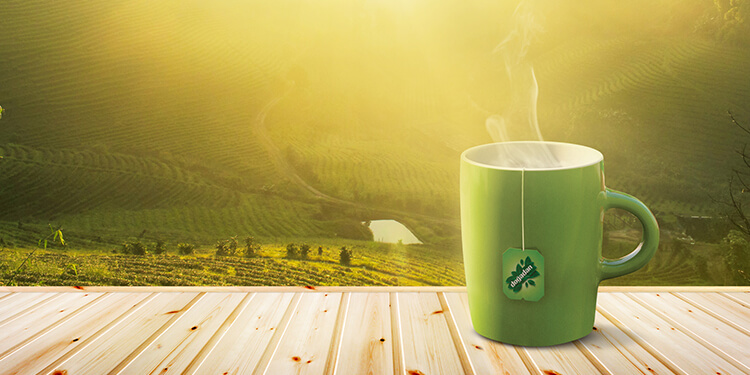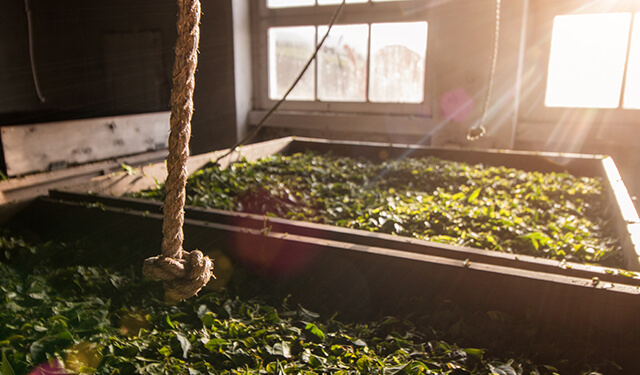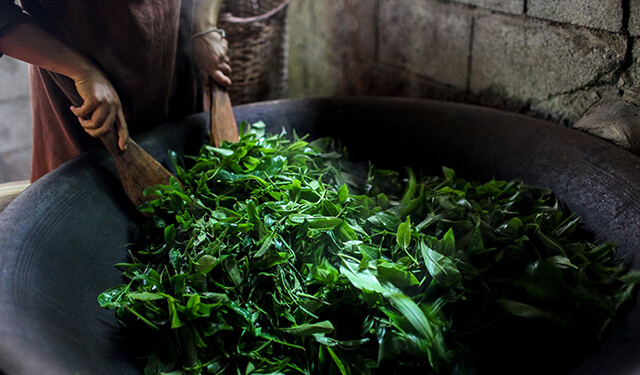

Tea leaves are generally harvested in three different ways around the world: hand picking, with scissors or with machines. In China, India and Sri Lanka, leaves are plucked manually. The methods depend on the type and characteristics of the tea to be produced. Some teas only require their buds to be plucked (e.g. Silver Needle), while others may require 1 leaf and 1 bud or 2 leaves and 1 bud to be plucked. Since hand picking allows for a more controlled operation, this method is indispensable for a premium production. Use of scissors is a popular method in our country. For example, the desired plucking method for the Turkish Black Tea grown in the Black Sea Region is 2 leaves and 1 bud. This makes it possible for delivering high-quality products.
In countries like Japan, we can see that tea is harvested in flat areas with machines.
The purpose of the withering process is to reduce/evaporate the water in the tea leaf and make it easier to roll. Spreading them on the ground or using airflow systems causes the leaves to lose a certain amount of their water content. This process should be carried out as naturally as possible, without rushing it or burning the leaves as it affects the taste, bitterness and quality of tea. The method, however, may vary depending on the type of tea to be produced. For example, in the production of some special teas, sun drying may be preferred if the weather conditions are ideal. In industrial black tea production, withering is done in a controlled manner, considering numerous parameters such as thickness of spread, temperature and humidity in the air, water content of the leaves etc.


Regardless of the rolling method, small parts of the leaves break off during the rolling process. This process, which can be done manually, by using pans or with rolling machines (with/without a press mechanism) rolls the leaves into wrinkled, sphere-like shapes. This rolling action also causes some of the sap, essential oils, and juices inside the leaves to ooze out and oxidize, resulting in enzymatic reactions. This process influences various characteristics of the tea such as aroma, bitterness, strength, leaf size and spiral shape.
Generally, the oxidation process is required for black tea and oolong teas in order to achieve their true brewed color and extract a variety of aroma compounds.For an effective oxidation, the bruised and rolled tea leaves are left inside a climate-controlled room.Carrying out this step in a controlled manner is critical for maintaining a certain standard for production.
Oxidation affects the formation of the flavor profile and brewed color of the tea.
The oxidation for oolong teas is stopped half-way. Therefore, we can see a lot of oolong varieties ranging in characteristics that are similar to green teas and black teas.


The drying process is carried out in furnaces where the water level is reduced to 3-7% to prevent microbial growth. This is necessary for the safe storage of tea. The drying process has a great effect on taste. High-temperature drying may result in undesirable results such as loss of aromatic compounds and a smoky flavor.
In this process, the dried tea is separated from its stem and other impurities that may get mixed into the leaves. In addition, different types of leaves are sorted according to their properties and sizes by using sieves and special systems. Teas around the world are graded according to their sizes and properties (BOP, PEKO, TGFBOP, BP, etc.).
Apart from these production stages, there are many other different techniques used worldwide.
For teas that cannot be rolled, rotorvane systems or different rolling techniques (CTC, LTC) can be used. The rolling process can be applied manually or with pans depending on the desired form.
Since producers want to avoid oxidation for white and green teas, they may employ additional processes such as steaming and pan-firing or skip some of the steps.
Moreover, some special production operations may include roasting. Sometimes, different ingredients can be added to the formulation of the finished product (e.g. jasmine, corn, etc.).